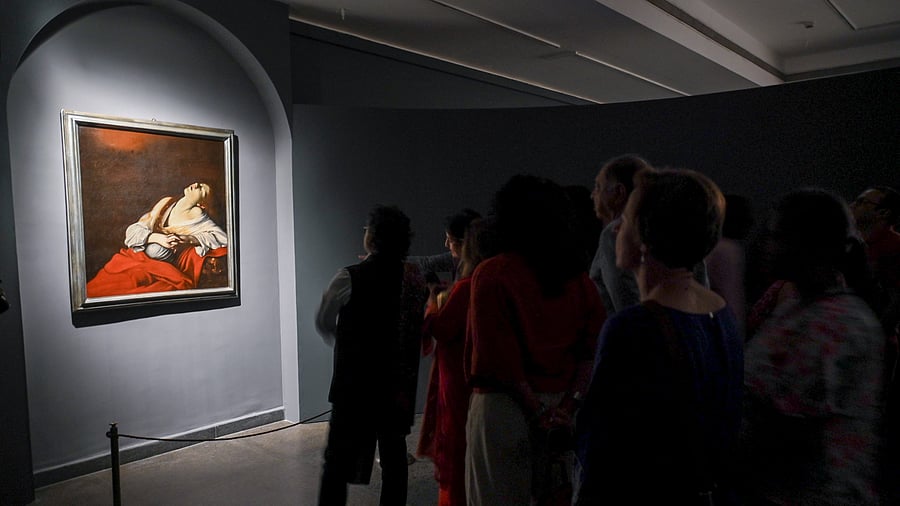
Renowned artist Caravaggio’s masterpiece ‘Mary Magdalen in Ecstasy’ unveiled at National Gallery of Modern Art, in Bengaluru on Friday. The exhibition is open to public from 14 June to 6 July.
Credit: DH Photo
The National Gallery of Modern Art in Vasanthnagar has reported a 20-30% increase in footfall since the arrival of Michelangelo Merisi da Caravaggio’s seminal 17th century painting ‘Mary Magdalene in Ecstasy’ on June 14. Over the last weekend, they saw over 650 visitors per day, says Subarna Patro, curator of the gallery.
Italian consul general, Alfonso Tagliaferri, was instrumental in bringing the 40.75 inch x 36 inch piece to Bengaluru from New Delhi, where it was on view at the Kiran Nadar Museum of Art. The artwork, originally completed around 1606, was lost until 2014. It is valued at 50 million euros. “When I heard it was in India, I wanted to make sure it comes to Bengaluru,” says Tagliaferri.
Tagliaferri then got permission from the painting’s owners and raised funds to bring the piece to the city. “The major costs were shipping, insurance, and owner’s fee,” he shares. NGMA is booked for three years because of a backlog of exhibitions caused by the pandemic, but they made an exception for the work by the Baroque artist.
The painting was transported from Delhi by air “by one of only three-four companies worldwide that specialises in transporting artwork of this level”. It came in a custom-made case under temperature-controlled conditions and was left to rest for a few hours after arrival.
At NGMA, the space where the work is housed was painted a sombre grey and the illumination changed to complement the piece, lauded for its chiaroscuro — use of light and dark contrast to add texture and depth. It was one of Caravaggio’s signature techniques. “The painting sits in an arch and the walls on either side are curved, to replicate 17th century Italian architecture,” Tagliaferri shares.
The team at the gallery has also installed a dehumidifier to control the humidity.
Priya Chauhan, associate curator at Museum of Art and Photography, paid the gallery a visit over the weekend. “It’s rare to come across a work like this outside of textbooks or European museums. Caravaggio’s life was as dramatic as his work. This painting is believed to be made while he was on the run (after being accused of murder) — it carries that tension. The chiaroscuro, the realism in the form, the break from idealised beauty is powerful to witness up close,” Priya notes.
For Giridhar Khasnis, artist and art critic, masterworks like Caravaggio’s cannot be viewed as objects, but as a phenomenon. “Caravaggio produced this while going through a difficult period. This must have been one of his last few masterpieces,” he points out. Viewing a piece of such historical importance in Bengaluru is exciting but rare. “Many years ago, there was an exhibition of Dutch masters at Chitrakala Parishat, a decade ago there was a travelling exhibition of British masters at NGMA. In Delhi and Mumbai one probably gets to see works of masters now and then, but we need more of these exhibitions in Bengaluru,” he states.